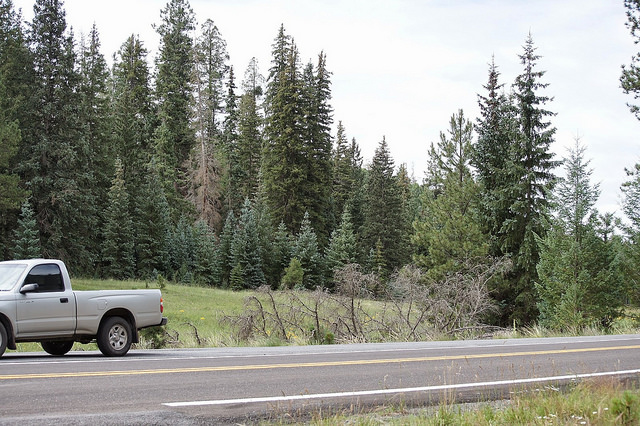All About Greenlee County
It's towns, it's place, it's size, it's habitats, it's birds...

Greenlee County, founded on March 10th, 1909, is located in the southeastern part of Arizona. It is Arizona's second smallest county behind Santa Cruz County in southern Arizona. Although Greenlee County is the second smallest county in Arizona by size, it is the smallest county in Arizona for human population. A 2015 population census ruled Greenlee County as that number, as less than 10,000 people call the county home.
There are only two towns in Greenlee County, several census designated places, and a handful of communities. The county seat is the memorable town of Clifton, which neighbors the census designated Morenci. Clifton and Morenci is where the main ecomony of Greenlee County is located, and that is due to the Morenci Mine. The Mine is a copper mine operation, and is the largest of such in North America, as well as one of the largest in the world. Driving through Clifton and Morenci creates a unique experience with the mining community. South of Clifton is the small town of Duncan with neighboring census designated places Franklin and York. The handful of communities are spread throughout the small county, and some of them include the popular Hannagan Meadow in the far northern reaches of Greenlee County, and also Blue, a tiny but interesting community along the Blue River, which is also in the northern part of the County.
Greenlee County is off the beaten path by many due to it's placement in Arizona. For most folks in Arizona's major cities, Greenlee County is a very long drive and is out of the way for most. Habitats found in Greenlee County or camping opportunities are easily met in other areas.
Despite the fact that Greenlee County isn't popular by census or by an abundance of tourists, the fact is, it's worth visiting for birders. It's a must visit. It's a must visit for birders because of it's place, because of it's size, because of it's habitats, and most important of all, because of it's birds.
For birding, Greenlee County is nothing short of interesting due to it's many habitats. The elevation ranges from just over 3000' in the south part of the county in Chihuahuan desert scrub and it tops out at over 9,000' in the White Mountains at the northern part of the county. From north to south in this County, an impressive array of habitats are found. They include Chihuahuan desert, grassland, agricultural fields, chaparral, pinyon pine and juniper woodlands, pine and oak forests, mixed conifer and aspen forests, as well as spruce-fir forest. One of the strongest aspects of Greenlee County for birding are it's riparian corridors that run through the diverse habitats mentioned. These are defined by creeks and major rivers that include Eagle Creek as well as the Gila, Black, San Fransisco, and Blue Rivers. Such impressive riparian areas like these mentioned have potential for an amazing variety of birds. What Greenlee County lacks is open water and marshy ponds that are publicly accessible. This makes finding water birds and shorebirds in the county difficult. No major water impoundments, lakes, or dams are found in Greenlee County.

Why Bird Greenlee County?
Greenlee County presents Arizona birders, as well as neighboring New Mexico birders, with unique opportunities. Statistic wise, Greenlee County has had less than 300 species recorded in it all time. It's by far Arizona's most under-birded county by a landslide. eBird shows it's clear lack of data. While Greenlee County's overall breeding birds have probably been sorted out in most ways due to the Arizona Breeding Bird Atlas Project, the County lacks any significant coverage otherwise. It's very rarely birded in winter as well as in migrations. That unique opportunity for birders is discovery. Because Greenlee County is so far east in it's placement in Arizona, it is prone to recieve attention from eastern songbirds. Several Mexican species who highly favor southeastern Arizona, such as Yellow-eyed Junco and Dusky-capped Flycatcher, have recently been discovered in Greenlee County. Could more of those characteristic Mexican birds who favor southeastern Arizona make their way to Greenlee? Possibly. Greenlee County has plenty of gaps missing on it's bird list. Many of those birds are water birds, but there are plenty of land birds too. Wouldn't it be fun to add those birds to the list and data?

About This Guide/Acknowledgements
What sparked my interest in birding in Greenlee County was simple, and I mentioned it above. It's under-birded by everybody, myself included. From what I've seen, I love Greenlee County and I love it's potential. My goal with this project is to update it when I visit Greenlee County and provide a tool for birders visiting the county who are looking for birds and places to bird. This project has a lot of work to be added to it in the future with the more spots I get to visit. In the meantime, I feel like I have enough information to get this online guide started.
I want to thank those who have helped me bird in Greenlee County, who are Gordon Karre, Joshua Smith, and Caleb Strand. I also want to thank Troy Corman, Eric Hough, Felipe Guerrero, Matt Baumann, and John Yerger for organizing AZFO Field Trips to Greenlee County, which has given me ideas of where to bird and birding approaches in the county. Thanks to Caleb Strand and Molly Pollock for reviewing Greenlee County on eBird. Finally, thanks to Troy Corman and Cathryn Wise-Gervais for the Arizona Breeding Bird Atlas Project, which has shaped so much of our understanding of Arizona's bird life. Thanks to Erin Bibles and Jim Gacey, who were regional coordinators for Greenlee County during the atlas project.

Back to Birding in Greenlee County |
